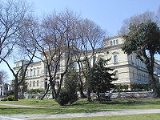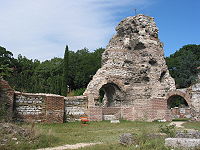
Varna Archaeological Museum
Encyclopedia



Museum
A museum is an institution that cares for a collection of artifacts and other objects of scientific, artistic, cultural, or historical importance and makes them available for public viewing through exhibits that may be permanent or temporary. Most large museums are located in major cities...
in the city of Varna
Varna
Varna is the largest city and seaside resort on the Bulgarian Black Sea Coast and third-largest in Bulgaria after Sofia and Plovdiv, with a population of 334,870 inhabitants according to Census 2011...
on the Black Sea
Black Sea
The Black Sea is bounded by Europe, Anatolia and the Caucasus and is ultimately connected to the Atlantic Ocean via the Mediterranean and the Aegean seas and various straits. The Bosphorus strait connects it to the Sea of Marmara, and the strait of the Dardanelles connects that sea to the Aegean...
coast of Bulgaria
Bulgaria
Bulgaria , officially the Republic of Bulgaria , is a parliamentary democracy within a unitary constitutional republic in Southeast Europe. The country borders Romania to the north, Serbia and Macedonia to the west, Greece and Turkey to the south, as well as the Black Sea to the east...
.
Founded on 3 June 1888, when a museum, part of the City Library was established, the Varna Archaeological Museum is situated in a historic building designed in the Neo-Renaissance
Neo-Renaissance
Renaissance Revival is an all-encompassing designation that covers many 19th century architectural revival styles which were neither Grecian nor Gothic but which instead drew inspiration from a wide range of classicizing Italian modes...
style by the noted architect Petko Momchilov and built in 1892–1898 for the Varna Girls' School. It became state property in 1945 and since 1993 the museum occupies all of the building, parts of which it has used since 1895.
One of the largest museums in Bulgaria, it features 2,150 m² of exhibition area and displays objects from the prehistoric, Thracian
Thracians
The ancient Thracians were a group of Indo-European tribes inhabiting areas including Thrace in Southeastern Europe. They spoke the Thracian language – a scarcely attested branch of the Indo-European language family...
, Ancient Greek
Ancient Greece
Ancient Greece is a civilization belonging to a period of Greek history that lasted from the Archaic period of the 8th to 6th centuries BC to the end of antiquity. Immediately following this period was the beginning of the Early Middle Ages and the Byzantine era. Included in Ancient Greece is the...
and Ancient Roman
Ancient Rome
Ancient Rome was a thriving civilization that grew on the Italian Peninsula as early as the 8th century BC. Located along the Mediterranean Sea and centered on the city of Rome, it expanded to one of the largest empires in the ancient world....
periods of the region's history, as well as from the times of the medieval Bulgarian
Bulgarian Empire
Bulgarian Empire is a term used to describe two periods in the medieval history of Bulgaria, during which it acted as a key regional power in Europe in general and in Southeastern Europe in particular, rivalling Byzantium...
and Byzantine Empire
Byzantine Empire
The Byzantine Empire was the Eastern Roman Empire during the periods of Late Antiquity and the Middle Ages, centred on the capital of Constantinople. Known simply as the Roman Empire or Romania to its inhabitants and neighbours, the Empire was the direct continuation of the Ancient Roman State...
s, the Ottoman rule
Ottoman Empire
The Ottoman EmpireIt was usually referred to as the "Ottoman Empire", the "Turkish Empire", the "Ottoman Caliphate" or more commonly "Turkey" by its contemporaries...
and the Bulgarian National Revival
Bulgarian National Revival
The Bulgarian National Revival , sometimes called the Bulgarian Renaissance, was a period of socio-economic development and national integration among Bulgarian people under Ottoman rule...
(including about 900 medieval and Revival icon
Icon
An icon is a religious work of art, most commonly a painting, from Eastern Christianity and in certain Eastern Catholic churches...
s).
The Museum's arguably most celebrated exhibit is the Gold of Varna, the oldest gold treasure in the world, excavated in 1972 and dating to 4600-4200 BCE, which occupies three separate exhibition halls.
The museum also manages two open-air archaeological sites, the large Roman baths
Roman Baths
The Roman Baths complex is a site of historical interest in the English city of Bath. The house is a well-preserved Roman site for public bathing....
in the city centre and the medieval grotto
Grotto
A grotto is any type of natural or artificial cave that is associated with modern, historic or prehistoric use by humans. When it is not an artificial garden feature, a grotto is often a small cave near water and often flooded or liable to flood at high tide...
of Aladzha Monastery
Aladzha Monastery
Aladzha Monastery is a medieval Orthodox Christian cave monastery complex in northeastern Bulgaria, 17 km north of central Varna and 3 km west of Golden Sands beach resort, in a protected forest area adjacent to the Golden Sands Nature Park.The monastery caves were hewn into a 25-m high...
at Golden Sands Nature Park
Golden Sands Nature Park
Golden Sands Nature Park is a national park on the Bulgarian Black Sea Coast in Varna Province. It is spread on an area of 1320.7 hectares. The park is 9.2 km long and on the average 1.2 km wide; it was declared a protected territory in 1943...
.
Four other sites are undergoing conservation and will be added to the museum roster: the 4-5th-century episcopal basilica on Khan Krum Street; the basilica and monastery of the same period at Dzhanavara; the 9-10-century Theotokos
Theotokos
Theotokos is the Greek title of Mary, the mother of Jesus used especially in the Eastern Orthodox, Oriental Orthodox, and Eastern Catholic Churches. Its literal English translations include God-bearer and the one who gives birth to God. Less literal translations include Mother of God...
monastery and scriptorium of the Preslav Literary School
Preslav Literary School
The Preslav Literary School was the first literary school in the medieval Bulgarian Empire. It was established by Boris I in 885 or 886 in Bulgaria's capital, Pliska...
at Pchelina; and the mediaeval fortified settlement of Kastritsi at Euxinograd
Euxinograd
Euxinograd is a former late 19th-century Bulgarian royal summer palace and park on the Black Sea coast, north of downtown Varna. It is currently a governmental and presidential retreat hosting cabinet meetings in the summer and offering access for tourists to several villas and hotels...
.
The museum has also a library, a children's study museum, a gift shop, and a cafeteria. Its courtyard lapidarium hosts the annual Varna Summer International Jazz Festival.

